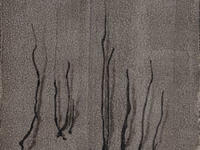
Weekdays 9 - 4
Works by Laura Mosquera, Natalija Mijatovic, Kirsten Moran, Stephen Knudsen, Kenny Jensen, and Ronnie Rysz
Exhibition curated by Jon Seals (M.A.R. ‘15)
Opening reception: Wednesday, March 9 | 5 - 7 pm | Sterling Divinity Quadrangle
The Norwegian painter and printmaker Edvard Munch wrote, “Death is the birth of life.” He spent most of his artistic career working in the artistically fertile grounds of the grave. His celebrated series Frieze of Life includes six versions of the painting titled The Sick Child. These are variations of works depicting his sister’s death; Munch created these images over the course of forty years. For this artist the series was as inescapable as death itself. Paradoxically, through his work on Frieze of Life, Munch chased and pushed his paint into death’s own face - scrapped, dragged, and clawed his materials through the realization and actualization of mortality. In these ways, art for Munch was not a distraction from life or death, but a way through his own life and the deaths of those he loved.
In one of Munch’s last works, Self Portrait Between the Clock and the Bed, the artist depicted himself standing between two symbols of death, in a vibrant room flooded with light and ringed round by his own paintings. Munch hovers there in the midst of his own mortality, challenging the viewer to consider his or her own life’s work. Munch is not alone in this spiritual and artistic endeavor. Mortality has been a universal theme in art throughout time and location, regardless of age, gender, or ethnicity.
Many observers have entered their own anxiety through an artist’s wounds on canvas and found kindred spirits: artists that may know some of their own pain. Others have found sobering echoes of joy and exuberance in art that encourages its viewers to live life well. Thankfully Munch did not create his Frieze of Life with only two themes, death and anxiety, but balanced these with a third theme, that of love (albeit a fractured love). His personal writings demonstrate that he allows for, and in some cases hopes for, love to enter in; this love includes and presupposes divine love
What can we learn from the visual arts about mortality within a context of a Divinity School? The intent of this exhibition is to challenge students, faculty, staff, and visitors of Yale Divinity School and the Institute of Sacred Music with works of art that investigate the motif of mortality through six distinct artistic explorations. Each artist directly or indirectly works with themes of death in myriad ways. They encourage us to learn more about our own life in the midst of death, and ask us to help others do the same, as we all stand, between clock and bed, surrounded by what has been made and what is to be made of it.
Presented with support from Yale Divinity School